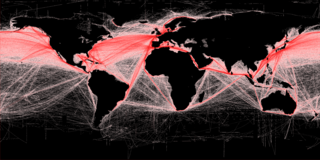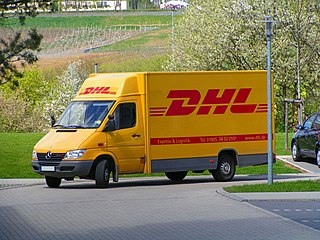History
Van Gend & Loos was established by the Antwerp-based innkeeper and carriage driver Jan-Baptist van Gend. He had married a woman from the Loos family in 1796. When Van Gend's brother-in-law Petrus Josephus Loos died in 1809, his diligence company was merged with Van Gend's company to form Van Gend & Loos.
The De Algemeene Postwagen Onderneming J.B. van Gend & Loos (General Postal Carriage Company J.B. van Gend & Loos) gradually expanded its network of diligence services, to transport passengers, goods and money. The company remained active in the Low Countries (and beyond) when Belgium became independent from the Netherlands in 1830.
Van Gend & Loos had trouble keeping up with competition from rail transport. Diligence services between places that also had a railway connection, had to be abandoned. Van Gend & Loos did offer a connection to places where a railway hadn't yet been constructed, but the number of such places declined with the expansion of the railway system. Disestablishment of the company was even considered in the 19th century.
Van Gend & Loos was purchased by employee Hipolyte Colignon, who revitalised the company. He abandoned passenger transport, and focussed on the transport of break bulk cargo from and to railway stations. To this end, he signed deals with railway companies.
Railway companies in their turn had trouble keeping up with the competition from motorised traffic, particularly trucks, vans and buses, in the 1920s. The national railroad company established the Algemeene Transport Onderneming (ATO; General Transport Company), which used both buses and trucks. The ATO was intended to transport break bulk cargo from and to the railway stations, which had been Van Gend & Loos' market. In 1928, the national railway company took over Van Gend & Loos. The N.V. Expeditie Onderneming Van Gend & Loos switched to trucks, and grew significantly.
Important railway stations had large warehouses, with freight wagons on one side, and grey and orange Van Gend & Loos trucks and vans on the other side. The corporate headquarters were moved to Utrecht in 1960, near the headquarters of the Nederlandse Spoorwegen, the Dutch railway company.
Van Gend en Loos v Nederlandse Administratie der Belastingen (1963) was a case that gave Van Gend en Loos a place in the history of European Union law.

Freight transport is the physical process of transporting commodities and merchandise goods and cargo. The term shipping originally referred to transport by sea but in American English, it has been extended to refer to transport by land or air as well. "Logistics", a term borrowed from the military environment, is also used in the same sense.

Containerization is a system of intermodal freight transport using intermodal containers. The containers have standardized dimensions. They can be loaded and unloaded, stacked, transported efficiently over long distances, and transferred from one mode of transport to another—container ships, rail transport flatcars, and semi-trailer trucks—without being opened. The handling system is completely mechanized so that all handling is done with cranes and special forklift trucks. All containers are numbered and tracked using computerized systems.

A van is a type of road vehicle used for transporting goods or people. Depending on the type of van, it can be bigger or smaller than a truck and SUV, and bigger than a common car. There is some varying in the scope of the word across the different English-speaking countries. The smallest vans, microvans, are used for transporting either goods or people in tiny quantities. Mini MPVs, compact MPVs, and MPVs are all small vans usually used for transporting people in small quantities. Larger vans with passenger seats are used for institutional purposes, such as transporting students. Larger vans with only front seats are often used for business purposes, to carry goods and equipment. Specially-equipped vans are used by television stations as mobile studios. Postal services and courier companies use large step vans to deliver packages.

DHL International GmbH (DL) is an international courier, package delivery and express mail service, which is a division of the German logistics firm Deutsche Post. The company delivers over 1.5 billion parcels per year.

The Deutsche Post AG, operating under the trade name Deutsche Post DHL Group, is a German multinational package delivery and supply chain management company headquartered in Bonn, Germany. It is one of the world's largest courier companies. The postal division delivers 61 million letters each day in Germany, making it Europe's largest such company. The Express division (DHL) claims to be present in over 220 countries and territories.
Cargo consists of bulk goods conveyed by water, air, or land. In economics, freight is cargo that is transported at a freight rate for commercial gain. Cargo was originally a shipload but now covers all types of freight, including transport by rail, van, truck, or intermodal container. The term cargo is also used in case of goods in the cold-chain, because the perishable inventory is always in transit towards a final end-use, even when it is held in cold storage or other similar climate-controlled facility. The term freight is commonly used to describe the movements of flows of goods being transported by any mode of transportation.
In European Union law, direct effect is the principle that Union law may, if appropriately framed, confer rights on individuals which the courts of member states of the European Union are bound to recognise and enforce.

A swap body, swop body, exchangeable container or interchangeable unit, is one of the types of standard freight containers for road and rail transport.

A Travelling Post Office (TPO) was a type of mail train used in Great Britain and Ireland where the post was sorted en route.

Rail freight transport is the use of railroads and trains to transport cargo as opposed to human passengers.

Parcel post is a postal service for mail that is too heavy for normal letter post. It is usually slower than letter post. The development of the parcel post is closely connected with the development of the railway network which enabled parcels to be carried in bulk, to a regular schedule and at economic prices. Today many parcels also travel by road and international shipments may travel by sea or airmail.

A freight forwarder, forwarder, or forwarding agent, is a person or company that organizes shipments for individuals or corporations to get goods from the manufacturer or producer to a market, customer or final point of distribution. Forwarders contract with a carrier or often multiple carriers to move the goods from one country to another.

A box truck—also known as a box van, cube van, bob truck or cube truck—is a chassis cab truck with an enclosed cuboid-shaped cargo area. On most box trucks, the cabin is separate to the cargo area, however some box trucks have a door between the cabin and the cargo area.
Mammoet is a privately held Dutch company specializing in engineered heavy lifting and transport of oversized and heavy objects.

In road transport, an oversize load is a load that exceeds the standard or ordinary legal size and/or weight limits for a truck to convey on a specified portion of road, highway or other transport infrastructure, such as air freight or water freight. In Europe it may be referred to as special transport or heavy and oversized transportation. There may be load per axle limits. However, a load that exceeds the per-axle limits, but not the overall weight limits, is considered overweight. Examples of oversize/overweight loads include construction machines, pre-built homes, containers, construction elements.
Van Gend en Loos v Nederlandse Administratie der Belastingen (1963) Case 26/62 was a landmark case of the European Court of Justice which established that provisions of the Treaty Establishing the European Economic Community were capable of creating legal rights which could be enforced by both natural and legal persons before the courts of the Community's member states. This is now called the principle of direct effect. The case is acknowledged as being one of the most important, and possibly the most famous development of European Union law.
A specialized set of jargon describe the tools, equipment, and employment sectors used in the trucking industry in the United States. Some terms may be used within other English-speaking countries, or within the freight industry in general. For example, shore power is a term borrowed from shipping terminology, in which electrical power is transferred from shore to ship, instead of the ship relying upon idling its engines. Drawing power from land lines is more efficient than engine idling and eliminates localized air pollution. Another borrowed term is "landing gear", which refers to the legs which support the front end of a semi-trailer when it is not connected to a semi-truck. Some nicknames are obvious wordplay, such as "portable parking lot", in reference to a truck that carries automobiles.
Gastor and Nestor were two LNG carriers built at the French shipyard Chantiers de l'Atlantique in Saint-Nazaire. Although delivered in 1976 both ships only entered real service in 1993, after their sale to Bonny Gas Transport Bermuda Shell, a subsidiary of Nigeria LNG Limited. Under their original names, the ships never transported any cargo.
Van der Schuyt, Van den Boom en Stanfries NV, or S.B.S. NV was a Dutch transport company. It was founded in 1948 in a period of change, when shipping companies were becoming trucking companies. It was a merger of three of the biggest inland shipping companies, originally offering scheduled and combined services for passengers, livestock and freight:
The Dutch Catholic Union of Transport Personnel, also known as "Sint Raphaël", was a trade union representing workers in the transport industry in the Netherlands.














